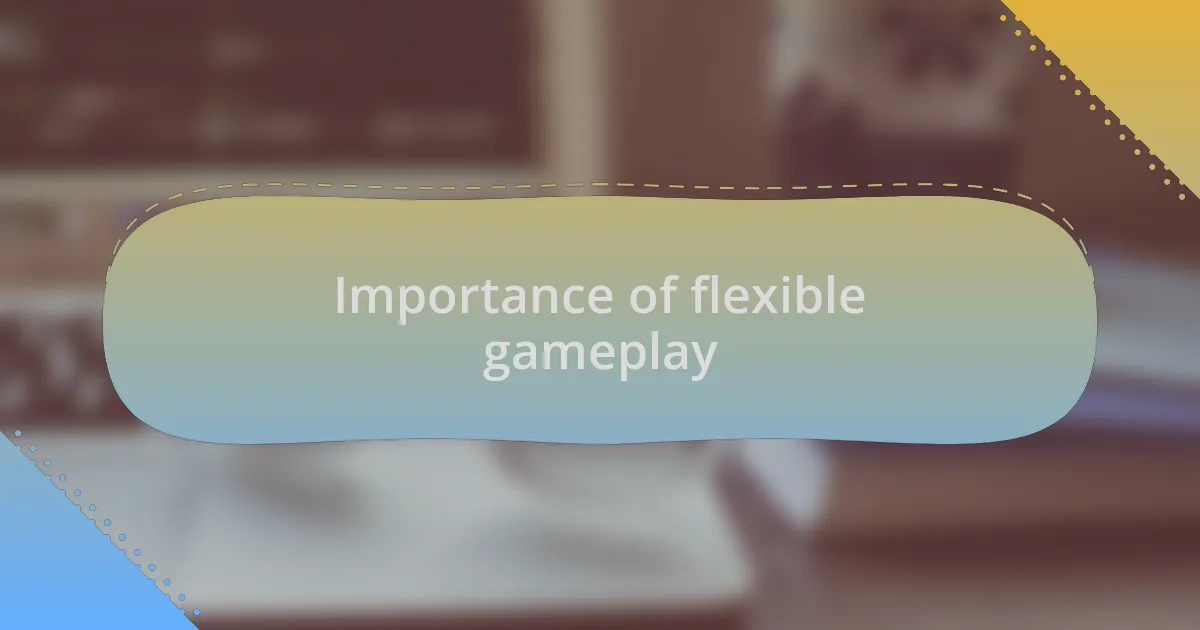Key takeaways:
- Flexible gameplay enhances player engagement by allowing personalized experiences, meaningful choices, and emotional connections.
- Key programming concepts, such as modular design and event-driven programming, enable dynamic responses to player actions and enhance game flexibility.
- Implementing dynamic content, like procedural generation and player-generated content, increases replay value and fosters a vibrant game community.
- Continuous testing and player feedback are essential for refining gameplay mechanics and maintaining a flexible gaming experience that evolves with player needs.

Understanding flexible gameplay
When I think about flexible gameplay, the first thing that comes to mind is the ability to adapt game mechanics to different player styles. For instance, in one of my own projects, I noticed how allowing players to choose their paths instead of following a linear storyline drastically changed their engagement levels. Isn’t it fascinating how a simple switch in design can lead to a more personalized experience?
One of the emotional highs I experience while designing games is witnessing players find their unique strategies. It’s truly rewarding when a player shares how they tackled a challenge in a way I never anticipated. This flexibility not only enhances player enjoyment but also creates a sense of ownership over their gameplay experience. What’s stopping us from incorporating even more avenues for player expression?
Moreover, flexible gameplay means embracing unpredictability. When I designed a game with dynamic environments that changed based on player choices, I realized how much it added to the narrative depth. Can you imagine the excitement players feel when their decisions shape the world around them? This approach invites players to invest themselves fully, making every choice impactful and memorable.

Importance of flexible gameplay
Flexible gameplay is crucial because it empowers players to make meaningful choices that resonate with their individual preferences. I remember testing a game where players could alter their character’s abilities based on their gameplay style. The excitement in the testing room was palpable as everyone discovered unique combinations, proving that when players feel they can control their journey, their investment in the game deepens.
Another aspect I value is the emotional connection flexible gameplay fosters. In one of my earlier projects, I introduced multiple narrative paths, and watching players form emotional attachments to different storylines was enlightening. Wouldn’t it be gratifying to know that your design led to heartfelt connections between players and the game’s world?
Lastly, flexibility can drive game longevity. I once implemented a feature known as ‘adaptive difficulty’, which adjusted challenges based on player progress. The feedback was overwhelming. Players appreciated that the game evolved with them, ensuring they stayed engaged over time. Isn’t it powerful to think that flexibility can transform a one-time experience into an ongoing journey for players?

Key programming concepts for flexibility
When I think about key programming concepts for flexibility, one of the first things that comes to mind is the importance of modular design. By breaking down game components into smaller, interchangeable modules, I’ve observed how easily features can be modified or expanded without disrupting the entire system. For instance, while developing a game level, I was able to swap out enemies based on player difficulty preferences without needing to redesign the whole scene. Isn’t it fascinating how this approach allows for instant adjustments?
Another concept that stands out is the implementation of event-driven programming. This strategy allows me to create systems that respond dynamically to player actions, leading to a more immersive experience. I remember a project where I utilized events to trigger unique animations and dialogues based on player choices. The thrill of seeing not just one, but multiple outcomes based on decisions made was incredibly rewarding. Don’t you think that real-time feedback makes the gameplay more engaging and personalized?
Lastly, I find that leveraging APIs can significantly enhance flexibility. By integrating external libraries or services, I can add functionality to my games that would otherwise take weeks to develop. In one instance, I incorporated a weather API into a game, allowing the environment to change based on real-world conditions. It added a layer of realism that players truly appreciated. Have you ever considered how such integrations can elevate a game’s engagement factor?

Designing adaptable game mechanics
Designing adaptable game mechanics often starts with the principle of reactivity. I’ve found that creating systems where game mechanics can adjust in response to player behavior not only keeps the gameplay fresh but also deepens engagement. For example, while tweaking a stealth game, I introduced mechanics that changed enemy AI based on how often a player was detected. This added an unexpected twist that kept players on their toes, sparking their curiosity about what would happen next. Have you ever noticed how a game’s unpredictability can transform the experience from mundane to thrilling?
Another key aspect I’ve learned is the significance of player choice. Through my experience, allowing players to make meaningful decisions shapes not only their individual journeys but also influences the mechanics at play. In one game I developed, I included a branching path system where players could choose to ally with various factions, significantly altering the game mechanics as each choice led to different abilities and consequences. The satisfaction of watching players explore different paths and fully immerse themselves in their decisions was immensely fulfilling. Isn’t it incredible how a single choice can ripple through gameplay?
Furthermore, incorporating variable difficulty levels into the game’s mechanics can enhance adaptability significantly. I’ve discovered that providing adjustable difficulty not just caters to a wider audience but also fosters a sense of accomplishment for players of all skill levels. For instance, when I worked on an arcade-style fighter, I added a feature where difficulty adjusted based on the player’s performance in real-time. The excitement of seeing a player who previously struggled suddenly conquer a level rejuvenated their enthusiasm. Have you considered how empowering players with options can dramatically enrich their gaming journey?

Implementing dynamic content in games
When it comes to implementing dynamic content in games, I’ve often turned to procedural generation as a powerful tool. In one of my earlier projects, I used algorithms to create unique environments that changed each time a player entered, which not only added replay value but also sparked the thrill of exploration. Have you ever found yourself lost in a game, feeling like each corner holds a new surprise? That sense of adventure is precisely what dynamic content brings to the table.
Another fascinating aspect I’ve encountered is the integration of player-generated content. I once collaborated on a game where players could design their own levels and share them with the community. This not only expanded the game world exponentially but also fostered a vibrant ecosystem of creativity. It’s amazing to see how players take ownership of their experience; have you ever played a user-created level that felt more personal than the official ones?
Moreover, keeping player engagement high often means rotating events or quests that introduce new challenges and themes. I remember when I launched a time-limited event that intertwined with the overall story, adding layers to the narrative and enticing players to return for limited-time rewards. Isn’t it fascinating how a fresh storyline can breathe life into a game, making players feel like part of something larger than themselves?

Testing and refining gameplay flexibility
When I test gameplay flexibility, I find that player feedback is invaluable. In one instance, I hosted a small playtest session and watched players navigate through different gameplay modes. Their reactions helped me identify whether certain mechanics felt too rigid or, conversely, too chaotic. Have you ever noticed how a small tweak can vastly change a player’s experience? It’s those subtle shifts that often lead to deeper engagement.
Iterating based on testing results can be both enlightening and challenging. I remember refining a combat system after observing players struggle with timing. After making adjustments, I found that gameplay felt more natural and intuitive. Isn’t it rewarding to see players adapt and enjoy a system you’ve fine-tuned just for them? Each small change can turn frustration into excitement, enhancing overall gameplay flexibility.
Finally, I’ve learned that regularly revisiting gameplay mechanics is crucial for longevity. After launching a game, I like to set up analytics to monitor player behavior over time. There were moments when I realized certain features, originally deemed successful, became underutilized. Continuously analyzing this data helps in maintaining a flexible gameplay experience that evolves alongside player needs. It’s almost like having a conversation with the game itself, adapting as you learn more about your audience.

Sharing my gameplay flexibility journey
As I reflect on my journey toward achieving flexible gameplay, it’s striking how my initial vision transformed through real player interactions. One memorable instance was during a late-night brainstorming session when I decided to iterate on a puzzle mechanic after noticing players getting stuck. I realized that creating an intuitive hint system not only alleviated frustration, but also fostered a sense of accomplishment. Have you ever had a moment where a solution just clicked for you? Witnessing that moment with players filled me with a sense of purpose.
Through these experiences, I found that emotional resonance is vital in gameplay design. I’ll never forget the time a player shared how a narrative twist I implemented, which was initially a bold risk, created a powerful connection to the game’s world. It was rewarding to see how my choices could evoke genuine feelings, proving that gameplay flexibility is not just about mechanics; it’s also about storytelling. Isn’t it fascinating how a single narrative element can shift the entire player experience?
Ultimately, sharing my gameplay flexibility journey feels like an ever-evolving story. I often think about the piece of advice I received early on: to listen closely to player voices. Engaging with feedback through surveys and community forums has not only shaped my designs but has also made players feel valued in the creation process. What better way to create a game than inviting others to be part of its evolution?